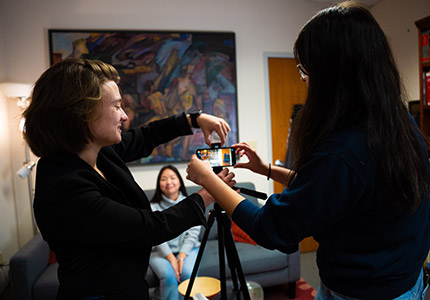When Leah Roemer ’23 and Sophie Hoblit ’23 enrolled in Berkeley Law’s Death Penalty Clinic last fall, they envisioned spending all year working on legal briefs for clients on death row. Instead, they found themselves behind a camera making a video to request clemency for a longtime clinic client.
This is the 22-year-old clinic’s first foray into the growing video defense strategy, which gives attorneys a way to be creative outside the rules and restrictions of formal legal pleadings. The clinic is preparing the request for clemency — the process by which a governor, president, or administrative board can reduce a defendant’s sentence or grant a pardon — in case litigation options fail.

“Once you get to this stage of proceedings in a state like Alabama, the traditional approaches have not worked, so we need to be creative,” says Supervising Attorney Mridula Raman, who will give a presentation on “Storytelling in Capital Clemency Campaigns” at an upcoming conference in London. “Having avenues to try different things is really helpful. But it’s not even a choice at this point. We have to think outside of the box to stand a real chance.”
Roemer, Hoblit, and their four teammates — classmates Dan Hilborn, Katie Melnick, Paloma Sat-Vollhardt, and Monica Van — built on the extensive work of clinic students from prior years, delving further into genealogy as well as juvenile justice and early childhood education records.
They traveled frequently to San Bernardino County, California, and Alabama, where each spent hours meeting with their client (who can’t be filmed or photographed in prison) and interviewing witnesses in person. The video includes interviews with a family member, a childhood family friend, a juror, and an expert witness, plus photos and papers documenting their client’s childhood abuse.
Humanizing the appeal process
“When you’re going through appeals, you rarely get the opportunity to put faces and voices to these characters in the story. Seeing someone and hearing them speak is harder to ignore than a dry stack of papers,” says Roemer, who will be a fellow at the Death Penalty Information Center this fall, researching and writing a report on prosecutorial misconduct in capital cases. “There aren’t any rules for where we are in our client’s case, so we’ve taken advantage of that by doing this direct, captivating video. We’re able to develop a more robust clemency petition because we have the luxury of time and manpower in the clinics.”
Unlike some public defender offices that might not have the bandwidth or resources to make videos, the clinic welcomes a new crop of students every year. Roemer and Hoblit worked with their four student teammates, Raman, and Co-Director Ty Alper to produce the video, which the clinic will have ready if its client receives an execution date.
Read full story at
Death Penalty Clinic Students Turn to Video as New Storytelling Strategy




